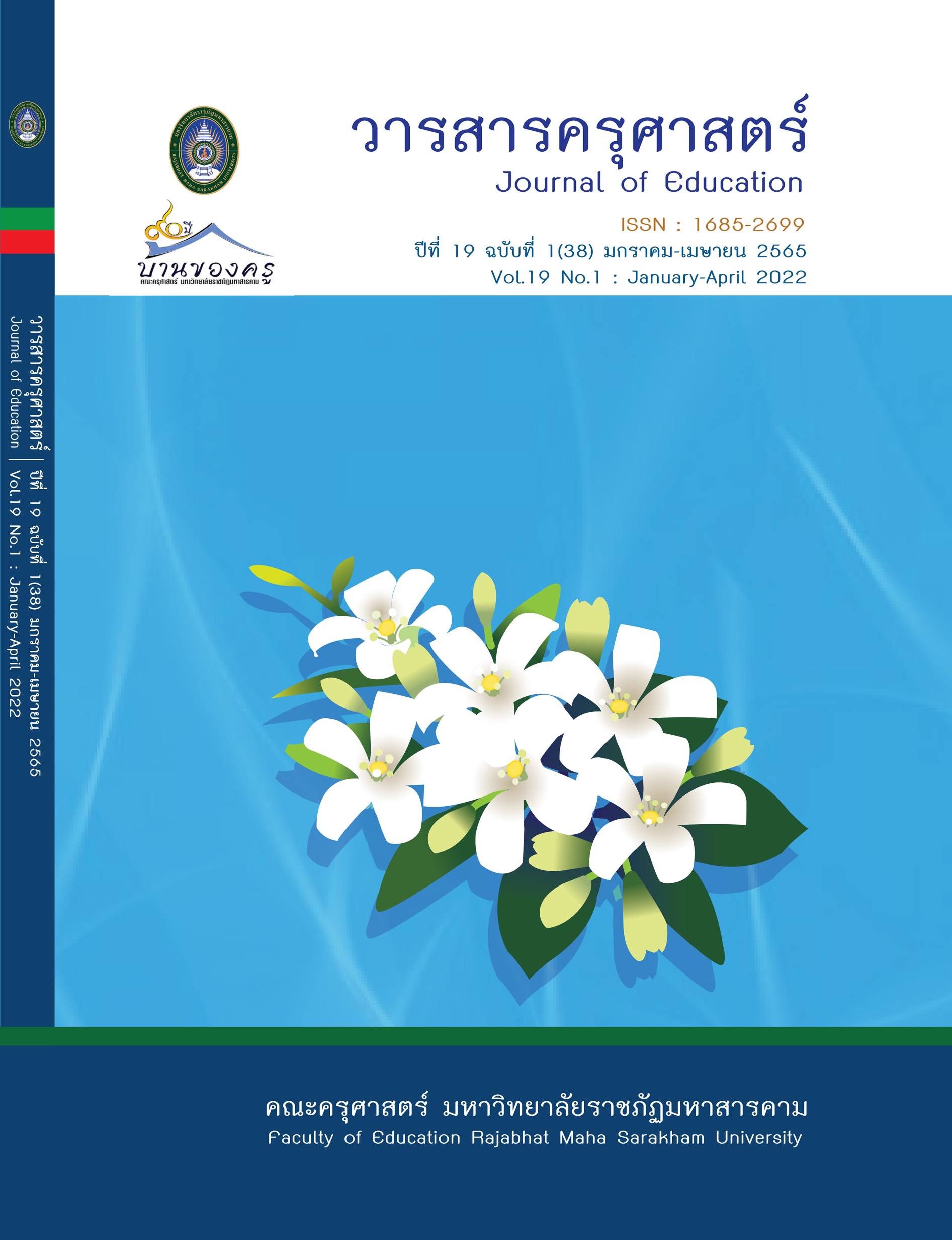Digital Skills of Teachers Affecting the 21st Century Classroom Management of Schools under Nakhon Phanom Secondary Educational Service Area Office
Main Article Content
Abstract
The purposes of this research were (1) to study and compare the digital skills of teachers classified by status and school size, (2) to study and compare the 21st-century classroom management of schools classified by status and school size and (3) to study the predictive power of digital skills of teachers affecting the 21st-century classroom management under the secondary educational service area office Nakhon Phanom. The samples were administrators and teachers under Nakhon Phanom Secondary Educational Service Area Office, totally 319 schools. A five-rating scales questionnaire was conducted for data collection. The data analysis were percentage, mean, standard deviation, t-test (Independent Samples), one-way analysis of variance analysis, and multiple regression stepwise.
The results were found that 1) the digital skills of teachers in overall were at a high level. In comparison, the digital skills of teachers classified by status were statistically significantly different at the .05 level and the digital skills of teachers classified by school-sizes were statistically significantly different at the .01 level. 2) The 21st-century classroom management of schools in overall were at a high level. In comparison, the 21st-century classroom management of schools classified by status were not different and the comparison of school sizes were revealed a statistically significant difference at the .01 level. And (3) There were variables digital skills of teachers affecting the 21st century classroom management of schools. could be predicted up to 84 percent, and the equation was written as follows.
Y' = 0.44 + .30 X3 + .20 X6 + .16 X5 + .12 X1 +.08 X2
Zy' = .40 Z3 + .22 Z6 + .18 Z5 + .13 Z1 +.09 Z2
Article Details

This work is licensed under a Creative Commons Attribution-NonCommercial-NoDerivatives 4.0 International License.
ข้อกำหนดเบื้องต้นที่ผู้นิพนธ์(ผู้ส่งบทความ) ควรทราบ
1. ผู้นิพนธ์ที่ประสงค์จะลงตีพิมพ์บทความกับวารสาร ตั้งแต่เดือนมกราคม 2563 เป็นต้นไป ให้ใช้รูปแบบใหม่ (Template 2563) โดยสามารถดูตัวอย่างได้ที่เมนู GUIDELINES
2. จะตีพิมพ์และเผยแพร่ได้ ต้องผ่านการประเมินจากผู้ทรงคุณวุฒิ (Peer Review)
3. การประเมินบทความโดยผู้ทรงคุณวุฒิ (Peer Review) เป็นแบบ Double Blind
4. การอ้างอิงบทความใช้หลักเกณฑ์ APA (American Psychological Association) คลิก
5. บทความถูกปฏิเสธการตีพิมพ์ ไม่ผ่านการประเมิน ผู้นิพนธ์ขอยกเลิกเองหรือชำระเงินก่อนได้รับการอนุมัติ ทางวารสารไม่มีนโยบายการคืนเงิน
References
จิณณวัตร ปะโคทัง. (2561). กลยุทธ์การพัฒนาผู้บริหารสถานศึกษามืออาชีพในศตวรรษที่ 21
สังกัดสำนักงานคณะกรรมการการศึกษาขั้นพื้นฐาน. วารสารศึกษาศาสตร์ มหาวิทยาลัยสารคาม, 12(1), 57–72.
ทวีศักดิ์ จินดานุรักษ์. (2561). นวัตกรรมในการบริหารจัดการชั้นเรียนเพื่อพัฒนาผู้เรียนให้มีทักษะศตวรรษที่ 21.
ในชุดวิชา 23728 นวัตกรรมการบริหารการศึกษาและภาวะผู้นํา. มหาวิทยาลัยสุโขทัยธรรมาธิราช.
นันทนัช สุขแก้ว,พร้อมพิไล บัวสุวรรณและวรรณวิศา สืบนุสรณ์ คล้ายจำแลง. (2563). ทักษะครูใน
ยุคดิจิทัล ของโรงเรียนสุรศักดิ์มนตรีสังกัดส สำนักงานเขตพื้นที่กำรศึกษามัธยมศึกษาเขต 2 [วิทยานิพนธ์
ปริญญามหาบัณฑิต]. http://edad.edu.ku.ac.th/Thesis%20IS%2026/12%20%20Nantanat.pdf
บุญชม ศรีสะอาด. (2560). การวิจัยเบื้องต้นฉบับปรับปรุงใหม่ (พิมพ์ครั้งที่ 10). สุวีริยาสาส์น.
พาสนา จุลรัตน์. (2561). การจัดการเรียนรู้สำหรับผู้เรียนยุค Thailand 4.0. วารสารคณะศึกษาศาสตร์
มหาวิทยาลัยศรีนครินทรวิโรฒ,11(2), 2376-2377.
พีระวัตร จันทกูล และฉลอง ชาตรูประชีวิน. (2560). รูปแบบการพัฒนาสมรรถนะครูในการใช้เทคโนโลยี
สารสนเทศและการสื่อสาร เพื่อการจัดการเรียนรู้ในศตวรรษที่ 21. วารสารศึกษาศาสตร์ มหาวิทยาลัย
นเรศวร, 19(3), 225-236.
แววตา เตชาทวีวรรณ และอัจศรา ประเสริฐสิน. (2559). การพัฒนาแบบวัดการรู้ดิจิทัลสําหรับนักศึกษา
ระดับปริญญาตรี. ภาควิชาบรรณารักษศาสตร์และสารสนเทศศาสตร์คณะมนุษยศาสตร์มหาวิทยาลัย
ศรีนครินทรวิโรฒ. https://drive.google.com/file/d/0B9Lre0aifCF2eXZ6SW1nRFRwaU0/view?usp=sharing
สำนักงานเขตพื้นที่การศึกษามัธยมศึกษานครพนม. (2564). แผนปฏิบัติการสํานักงานเขตพื้นที่การศึกษามัธยมศึกษา
นครพนม. https://www.sesaonkp.go.th/archives/1731
สำนักงานคณะกรรมการข้าราชการครูและบุคลากรทางการศึกษา. (2564). หลักเกณฑ์และวิธีการย้ายผู้บริหาร
สถานศึกษา สังกัดสำนักงานคณะกรรมการการศึกษาขั้นพื้นฐาน.
https://otepc.go.th/th/content_page/item/3267-3-2564.html
สุคนธ์ สินธพานนท์. (2558). การจัดการเรียนรู้ของครูยุคใหม่ เพื่อพัฒนาทักษะผู้เรียนในศตวรรษที่ 21. 9119 เทคนิค.
สุรางค์ โค้วตระกูล. (2556). จิตวิทยาการศึกษา (พิมพ์ครั้งที่ 11). สำนักพิมพ์แห่งจุฬาลงกรณ์มหาวิทยาลัย.
สมพร บัวกล่ำธนกิจ,ประพรทิพย์ คุณากรพิทักษ์ และวันทนา อมตาริยกุล. (2562). ทักษะครูในศตวรรษที่ 21 ที่ส่งผล
ต่อการเป็นชุมชนแห่งการเรียนรู้ทางวิชาชีพ ของครูผู้สอนในโรงเรียนที่สอนนักเรียนที่มีความบกพร่องทางการได้ยิน
สังกัดสำนักบริหารงานการศึกษาพิเศษ. วารสารวิจัยและประเมินผลอุบลราชธานี, 8(1), 54-57.
อรพรรณ ทิมครองธรรม, ทวิกา ประภา และสมจิตรา เรืองศร. (2560). ปัจจัยที่ส่งผลต่อการจัดการเรียนรู้ใน
ศตวรรษที่ 21 ของครูสหวิทยาเขตเบญจบูรพา สังกัดสำนักงานเขตพื้นที่การศึกษามัธยมศึกษา เขต 2.
วารสารบัณฑิตวิทยาลัย มหาวิทยาลัยรามคำแหง, 9(1), 102-106.
Bawden, D. (2001). Information and digital literacies: a review of concepts. Journal of Documentation, 57(2),
-259.
Ellina Sergeevna Anisimova, ES. (2020). Digital Literacy of Future Preschool Teachers. Journal of Social Studies
Education Research, 1(1), nl.
Jose Antonio, M. C., Yrene Cecilia, B. A., Roberto Vertiz, O., Jacinto Joaquin, I. A., Sandy Dorian, R. L. (2020).
Integration of ICTS and Digital Skills in Times of the Pandemic Covid-19. International Journal of Higher
Education, 9(9), 11-20.
Kauchak, D. and Eggen, P. (2006). Learning and Teaching. Research-Based Method (3nd ed). Allyn & Bacon.
Kline, R. B. (2005). Methodology in the social sciences principles and practice of structural equational
modelling.2nd ed.Guilford Press.
Monika, K. (2017). Digital skills in the EU labour market. European Parliamentary Research Service
Physical description. https://www.europarl.europa.eu/thinktank/nl/document/EPRS_IDA(2017)595889


